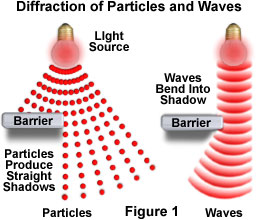Particle and Wave Diffraction
One point of view envisions light as wave-like in nature, producing energy that traverses through space in a manner similar to the ripples spreading across the surface of a still pond after being disturbed by a dropped rock. The opposing view holds that light is composed of a steady stream of particles, much like tiny droplets of water sprayed from a garden hose nozzle. This interactive tutorial explores how particles and waves behave when diffracted by an opaque surface.
The tutorial initializes with particles of monochromatic red light (photons) impacting the surface of a opaque light stop with an incident angle of approximately 90 degrees. Upon encountering the stop, particles are either deflected (not illustrated) or pass by the object undeviated. The Particle/Wave slider, located beneath the light stop, can be utilized to morph the beam of particles into a planar wavefront. Prior to becoming a wave, the particles align themselves in waves. Light waves interact with the light stop by diffracting (or bending) into the shadowed region behind the opaque barrier. The mouse cursor can be employed to drag the opaque light stop back and forth in front of the oncoming waves or particles.
Particles and waves should behave differently when they encounter the edge of an object and form a shadow (Figure 1). Newton was quick to point out in his 1704 book Opticks, that "Light is never known to follow crooked passages nor to bend into the shadow". This concept is consistent with the particle theory, which proposes that light particles must always travel in straight lines. If the particles encounter the edge of a barrier, then they will cast a shadow because the particles not blocked by the barrier continue on in a straight line and cannot spread out behind the edge. On a macroscopic scale, this observation is almost correct, but it does not agree with the results obtained from light diffraction experiments on a much smaller scale.

When light is passed through a narrow slit, the beam spreads and becomes wider than expected. This fundamentally important observation lends a significant amount of credibility to the wave theory of light. Like waves in water, light waves encountering the edge of an object appear to bend around the edge and into its geometric shadow, which is a region that is not directly illuminated by the light beam. This behavior is analogous to water waves that wrap around the end of a raft, instead of reflecting away.
Sorry, this page is not
available in your country.



